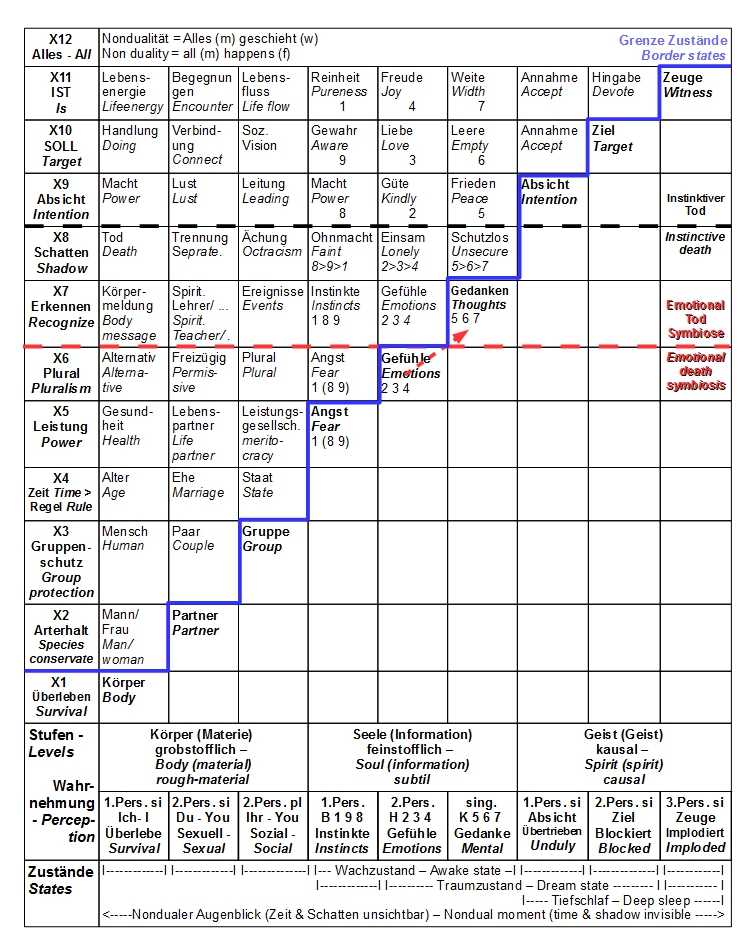Integral
Perspective Table
The presented 3-dimensional Integral Perspectives Pyramid IPP of consciousness in the previous chapter can also be figured as 2-dimensional table, as in Chap. Development Levels is shown already very universal, to show in the following additional informations.
Applied to the consciousness development and after comparison with the 12-dimensional Model by B. Heim it results in only one following table (IPT):

This spiritual perspectives model corresponds regarding to the axes roughly the Wilber-Comb-grid, though with more significant universality. The AQAL-parts of 12 levels and 4 states are integrated.
Levels & Quadrants:
Based on the above Chap. Holarchy Quadrants with the local 4 quadrants with each 2 dualities resulting the first 3 rough-material levels (duality: X1 I versus X2 You and duality: X1+X2 singular versus X3 You/We plural) of the indicated table. Thereafter following time as the fourth level (duality: X4 It/They as neutral view towards the personal levels X1-X3 I/You /You /We).
These dualities repeat in subtle information layers (X5-X8). Levels X5 and X6 include the controlling subtle information (duality: X5 I/We versus X6 You/Your). While the levels X7 and X8 correspond to information subtle program levels (duality: X7 singular versus X8 plural).
Finally, the 4 mental levels (X9-X11) have to be understand according to the chap. Holon Triangle (duality: X9 I versus X10 You and these personal views as a duality relation to the neutral conscious considerations X11. The final level X12 of nonduality is forming the total of 12 level.
States:
On the horizontal axis the possible states and levels of perception of human beings are shown. The 4 states can be each described by containing of certain perception types (rough-material, subtle, causal), wherein in total 9 perception layers can be determined. These are the rough material perspectives of relationship (I. You, You/We), subtle protection layers (instinctive, emotional, mental), causal reaction patterns (exaggerated, blocked, imploded), which create together the non-dual experience.
Each perception layer and each state can be experienced regardless of the level. But not all aspects of the levels can be experienced directly by perception layers or states and especially not consistently workable. Because states are limited to the own personal experience and thus at least exclude the 3rd person as objective consideration, appropriate level topics such as time (level X4) and shadow work (level X8) can not be experienced in a spontaneous and pure subjective view.
Below the rising diagonal border for states (blue line), every percepton layer can be experienced regardless of the level. By contrast a deeper exploration i.e. a higher level of experience of the respective state can be experienced only in depth and focused attention to this level of perception. However this is then prohibited by inner blockages and shade issues, which are differently strong hindering different levels of perception, explained in detail by the Chap. Basic Traumatization. However with each higher level mostly the level of the related perception is getting more conscious and definitly deeper integrated.
Lines:
With regard to the Integral Perspective Table ITP or the Integral Perspective Pyramid IPP above it is here also assumed a uncertainty between the viewing of the horizontal perception layer and vertical levels. Both show a partially guilty aspect of conscious experience. While the levels suppose a rigid, whole integrated sequence, the states overlooks time and shadow issues, but in reality there exists no complete integration of each level. The same applies to the consideration of a perception layer in opposite to other perception layers and of a level in opposite to another level.
Thus, an attempt is made by the idea of lines, to soften the rigid interpretation of the levels among themselves in order to depict the uncertyinty of consideration, thus complicating the model unnecessarily. On the one hand a pure stage consideration is to fix and at best be seen as statistical distribution, that actually has a spread around the average. The tendency in human for equalization of different levels to a single level, are in contrary to the shadow themes, see Chap. Basic Traumatization. Divergent lines on the other hand can be explained, because in the hierarchy of levels there is arranged mentally above emotionally above instinctively above bodily, and thus the cognitive line precedes inevitable, last one Ken Wilber has recognized.
Types:
Like in Chap. protection mechanisms described, a 3-dimensional protection mechanisms are formed in humans, which are shown optimal by type teaching of the enneagram. These are perspectives of relationship (1st person singular - I, 2nd person singular - You, 2nd person plural - You), protection layers (instinct level, emotional level, thinking level) and reaction patterns (exaggerated, blocked, imploded). These are related to the layers of perception and can thus be assigned to the levels, which allows allocation of the enneagram types 3x3x3=27 within the table.
In addition in the table, the mirror symmetry between level X1-X6 and X7-X12 is shown, which separates the upper spiritual non-energized area of the lower energized range. This level transition from X6 (1st tier) to X7 (2nd tier) is by various literature [2], [3], [13] delayed, which the traumatic repressed birth reminding to the resolution of the symbiosis of the embryo to the placenta can explain (type transitions, 2>5, 3>6, 4>7), see Chap. Integral Enneagram. The level transition from X8 (2nd tier) to X9 (3rd tier) is apparently again difficult, because here still unconscious moment of birth (type transition 9>1) with the getting conscious of the basic traumatisation has to be experienced, see Chap. Basic Traumatization.
Very generally, type models are collective concepts, that are associated with the collective information at level 8. The individual human takes, because of its still existing shadow parts, certain behaviors, that manifest themselves as characteristics, which can be associated as one type of each different type model. For the individual this affects especially the levels 7 or less, and can be observed accordingly.